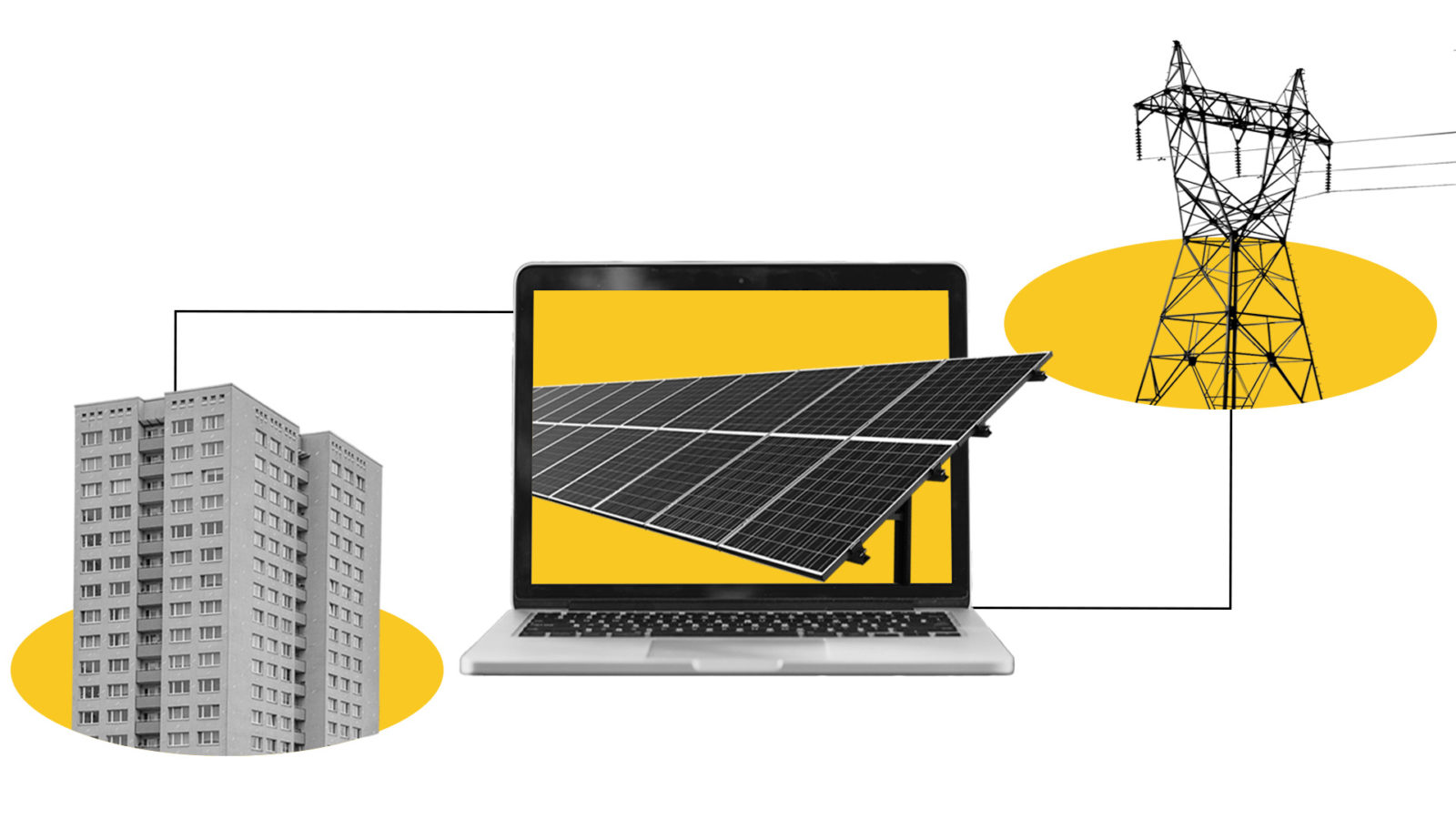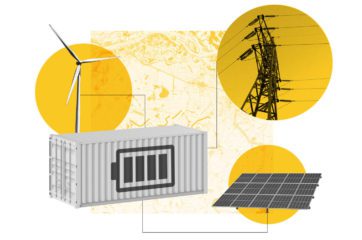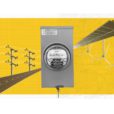Climate XChange’s Dashboard Digest is a deep dive on each of the policies that we track in the State Climate Policy Dashboard and an exploration of how these policies can interact with one another to form a robust policy landscape. The series is intended to serve as a resource to state policy actors who are seeking to increase their understanding of climate policies, learn from experts in each policy area, and view examples of states that have passed model policies. We’re beginning our series by exploring renewable energy and energy storage policies.
Many policy options exist for states to increase the electric grid’s supply of renewable energy. There are complex interactions between these policy mechanisms, and the order in which they’re implemented can affect their success. This framework, proposed by the National Renewable Energy Laboratory, is known as policy stacking.
First, states should reduce or remove barriers to renewable energy, which prepares the market. Then states can create demand for renewables by setting requirements for utilities and standards. Once fully developed policies in these first two tiers are in place, incentive-based policies have a higher chance for success in expanding the market. One of these policies, shared renewables, expands access to the benefits of renewable energy production, particularly for those who otherwise are unable to produce it.
This article is part of our Dashboard Digest series, where we dive deeper into the climate policies we track in our State Climate Policy Dashboard. In this article, we’ll explore what shared renewables are, how they can expand renewable energy production, and what makes these policies effective.
Read more about policy stacking in our previous Dashboard Digest article: Unlocking Renewable Energy Potential through Policy Stacking
Early Experiments Lead to State Policy
During the early 2000’s, residential solar power was beginning to take off, but the majority of people were unable to access it. People have long seen the appeal of adding solar panels to their homes and businesses: they can produce clean power for themselves and reap financial benefits by selling excess power to their utility companies. Unfortunately many people are unable to do so because it is too expensive, they don’t own their home, or their buildings are covered in too much shade.
Attempting to address these issues, communities around the country began to experiment with a way to expand access to solar power to anyone who wanted it. The first of these “community solar” experiments began in Ellensburg, WA in 2006. In an article published by Grist, the city’s Resource Manager, Gary Nystedt, said that there was a lot of interest from city residents to install solar, but they were running into a number of problems.
Gary came up with a novel idea for his community: the city would build a solar array, and residents could buy into the project without having to install anything on their own properties. The city charged each subscriber for membership to the solar array and promised that they would receive a credit on their electricity bill. Though the project was initially very small, this became the country’s first solar garden and other communities began to expand on the concept.
Other states, including California and Massachusetts, built on Ellenburg’s experiment trying out new, but similar ideas. In 2008, the California Public Utilities Commission created the multifamily affordable solar housing (MASH) initiative which allowed low-income residents to receive credits on their electricity bills for solar panels on the roof of their apartment buildings. Massachusetts created their own form of community solar known as “neighborhood net metering” where one customer with rooftop solar could share the energy generation with at least ten nearby residents.
Though many parts of the country were experimenting with this form of shared renewables, the programs were varied and benefits were inconsistent. It was clear that for shared renewables to really catch on, there would need to be some form of standardization at the state level.
By 2010, the garden only contributed 0.05 percent to the city’s power needs.
In 2010, Colorado became the first state to pass shared renewables legislation with the Community Solar Gardens Act. This new statewide pilot program allowed investor-owned utilities (IOUs) to create solar gardens and ensured that subscribers would be paid at the retail rate for their share of the electricity generated. The state is continuing to update the program’s details, and currently has 96 megawatts (MW) of community solar capacity.
Read more: Colorado’s Community Solar Program
How Do Shared Renewables Work?
Shared renewable policies allow people to purchase, lease, or subscribe to renewable energy from an off-site system, as opposed to a system like rooftop solar. Some states have legislation that allows for the sharing of other renewable technologies like wind and hydroelectric power, but community solar is the most common form with around 1,600 projects built across the country by the end of 2020. These policies are designed to benefit those who are unable to access distributed renewables due to cost, ownership status, or physical constraints.
Access to renewable energy production can be both beneficial for the individual and the entire energy grid, but shared renewable programs can vary widely in the benefits they provide. The best shared renewable policies provide financial incentives that encourage the expansion of renewable energy systems. This means that there should be some way for customers to be compensated for participating in a shared renewables system. There are two main policy instruments that states use to enable shared renewables: program-specific legislation or virtual net metering.
Program-Specific Legislation vs Virtual Net Metering
Some states, like Colorado, pass legislation that creates specific programs for shared renewables, setting up how generation facilities are created, who administers the program, and the details for compensation. Colorado’s Community Solar Gardens Act set up a program for customers of the state’s two IOUs: XCEL Energy and Black Hills Energy. It directed the state’s Public Utilities Commission to establish rules for how the shared renewables program would work, including a solar garden’s necessary subscribers, location, and compensation structure. The rules required the IOUs to adopt a solar garden program, but left it optional for municipal and cooperative utilities to participate with their own programs.
Other states opt to pass virtual net metering legislation, which enables shared renewable projects to develop. In regular net metering policies, ratepayers are credited for selling excess renewable energy that they generate on their property back to the utility. This policy, which has been around since the 1980’s, requires that the generation facilities are connected to the same meter that measures a property’s energy use — meaning you’d have to own the property to benefit from net metering. Virtual net metering allows for the same type of compensation but doesn’t require the generation facility to be located on the utility ratepayer’s property. This expands access to net metering benefits for people who are unable to install renewables at home. Similar to traditional net metering, the virtual policies will often have limits on system capacity, eligible technologies, and compensation rate.
In 2017, NREL found that 49 percent of households were unable to host a solar system due to a variety of reasons.
Ownership Models
Shared renewable projects can be owned and administered by a variety of different entities: community members, municipalities, vertically integrated utilities, or separate third parties (76 percent of community solar projects). Which ownership model a project has can shed light on who receives the most benefits.
For example, in an entirely community-owned and -operated project, the primary goal is usually to save subscribers money on their electric bills. The managers of the program are the people who are benefiting from the savings, so there is a lot of motivation to prioritize subscriber benefits.
On the other hand, some larger projects that are operated by utilities may be primarily intended to help meet renewable energy requirements. These projects also can benefit subscribers in the form of bill savings, but in some cases they don’t.
Third parties are non-governmental entities separate from utilities that own and operate community solar projects.
Not All Programs are Created Equal
The Duke Energy Shared Solar program operates for the vertically integrated utility’s customers in Florida, and is technically a shared renewables project. It’s useful to explain how this program works to distinguish this from a community solar program that benefits its participants.
First, Florida doesn’t have a statewide shared renewables policy, like a community solar pilot program or virtual net metering. This means that the state’s shared renewable resources come from voluntary utility participation and there aren’t rules or guidelines for program administration.
In Duke Energy’s Shared Solar program, the utility charges its customers for a subscription to a large solar project. The company markets this as a way for customers to participate in the production of clean energy without any of the hassle of installing anything at home.
This may sound a lot like other shared renewable programs, until you consider the benefits for subscribers. According to Duke Energy’s website, you only “…get the satisfaction of knowing that you’re supporting energy that’s being generated from Florida solar farms.” There are no promises of bill savings, in fact the credits that you receive for each kilowatt of solar energy you produce don’t even cover the amount you pay. The utility even provides an example energy bill for a shared solar customer, which clearly shows that overall monthly payments will increase with the subscription. One writer recommends this program only “…if, y’know, you hated having money.”
It’s important to point out that Duke Energy operates this program based on the historical and economic systems that permit vertically integrated utilities. These for-profit companies often say that their main concern is grid reliability, but customers rely entirely on state regulators to ensure that they are kept in check. A lack of a statewide shared renewables policy allows utilities to forgo fairly compensating community solar subscribers.
Vertical integration means that a utility controls all levels of the supply chain: electricity generation, transmission, and distribution.
Interestingly, Florida has the second highest installed shared solar capacity.
Shared Renewables Benefits
This is a non-comprehensive list of the advantages of a statewide shared renewables program or policy adapted from the Environmental Protection Agency:
Access to renewables for customers who can’t host systems. These policies expand access to people who can’t install solar panels due to a variety of reasons including high costs, ownership status, or physical property constraints.
Shared renewables are less of a commitment for customers. Even when a homeowner can install renewables on-site, it can be years until the investment breaks even after all of the costs of the system. Shared renewables, on the other hand, can allow subscribers to see immediate bill savings without the long-term financial commitments of rooftop solar.
Projects can be more cost effective due to economies of scale. This is beneficial for the overall economy and the electric grid as a whole, because it allows investments to go further. In terms of the overall cost vs energy output from a project, it’s more efficient to build large power facilities, like a shared renewables project, than to build many smaller ones, like rooftop solar. In larger projects, the costs are spread over a larger output of power, something that utility-scale power plants have always benefited from.
Shared renewable projects can make money for the ratepayer. Through virtual net metering or other forms of compensation, subscribers to shared renewables can benefit financially from their membership. In many programs, savings are guaranteed which can incentivize participation and the growth of shared renewable projects.
Customers are not responsible for the maintenance of the system. Subscribers to a shared renewable project can benefit from the bill credits or payments without the costs of maintaining the system.
The shared renewables market is rapidly growing. This benefits the renewables market as a whole because there are a lot of opportunities to participate in shared renewables — both for customers and investors. The country’s shared solar capacity has more than doubled on average each year since 2010 and projects have grown in both number and in size.
Read about the Levelized Cost of Energy, which compares the cost-competitiveness of renewable energy technologies.
One of the Downsides
When talking about renewable energy production, it’s also important to talk about how it is tracked: Renewable Energy Certificates (RECs). RECs are created when one megawatt of renewable energy is produced, and each REC can be traced to a specific megawatt of energy. This system is a way for states to track exactly how much renewable energy is produced, making sure that there is no double counting where multiple entities claim credit for the energy. Basically, whoever holds the REC is the one who can claim credit for that megawatt of renewable energy.
The problem with RECs and shared renewables comes from the fact that RECs have monetary value. Because RECs prove the “ownership” of renewable energy, utilities and companies need them to prove their compliance with renewable requirements or public commitments, and RECs are sold through statewide markets.
If you have rooftop solar, you receive the RECs for the energy that you generate. However, in most shared renewables programs, a subscription to a solar panel does not also give you ownership rights to the RECs that your subscription produces. The RECs will often remain with the owner of the facility, who can then sell them for a profit. This takes away energy ownership from shared renewables customers and subscribers cannot make legal claims for the production of renewable energy.
State Examples
Minnesota
In 2014, Minnesota passed legislation that created the Community Solar Garden Program, the country’s most successful statewide shared renewables program. Minnesota currently has the largest installed community solar capacity of any state at 841 megawatts. This program, which is administered by Xcel Energy, one of the state’s IOUs, allows utility customers to purchase subscriptions to solar gardens, which are owned by independent garden operators.
Solar garden facilities must have at least five subscribers and no one subscriber can have more than a 40 percent interest in the facility. Each subscription must produce at least 200 watts of energy and the customers must be located in the same county as the garden or one adjacent to the facility. Subscribers also receive a bill credit for energy that their subscription produces at the retail rate for electricity.
Minnesota’s shared renewables program may have the highest capacity of any state’s, but there’s a lot of room for growth in terms of equity. Even though most shared renewables programs address some of the financial constraints in benefitting from renewable energy, they can still leave out many low- to-moderate income households. For example, most of the solar gardens in Minnesota require subscribers to have a credit score of at least 680, which can exclude many potential applicants. Some say that using the credit score system at all disproportionately affects underprivileged communities. Additionally, most solar gardens exist outside of low-income neighborhoods, and because the program requires living near the facility, many households are left out.
According to the Consumer Financial Protection Bureau, at least 45 million adults lack enough credit history to even be given a credit score.
California
California leads the country in overall solar capacity, but has been thus far unable to develop a successful shared renewables program. However, if Governor Newson signs AB 2316, which the legislature passed last week, California’s new community solar program could soon be in the national spotlight.
This new community solar bill addresses some of the equity issues in programs like Minnesota’s. The legislation requires that at least 51 percent of a community solar farm’s capacity serves low-income subscribers. Additionally, projects must be built by workers who are paid prevailing wages, ensuring that these green jobs are desirable.
Read more about CA’s newly passed bill: California is Finally Unlocking Community Solar for the Masses
The program also introduces a compensation structure that incentivizes projects to be paired with advanced battery storage technologies. Utilities would be required to pay more for electricity that is delivered when it’s more valuable to the grid: at night or when demand is high. It’s likely that community solar projects will be paired with energy storage so that higher prices will save subscribers more on their energy bills.
Lastly, California is hoping that developing more community solar capacity will be helpful for the grid as a whole. Solar farms will be connected to local distribution grids, as opposed to the regional transmission networks. This means that in the event of a widespread outage, from an earthquake for example, community solar projects can still deliver power locally which makes the state more energy resilient.
Read more about energy storage: How Energy Storage Policies Can Allow Grids to Run on Renewables
About CNEE: The Center for the New Energy Economy was founded in 2011 as a department at Colorado State University by Colorado’s 41st Governor, Bill Ritter Jr. The Center convenes and facilitates dialogue among policymakers and stakeholders, connects energy policy leaders and experts, creates and maintains free, publicly available tools and resources, and publishes energy policy research.
About The State Policy Opportunity Tracker (SPOT) for Clean Energy: The SPOT for Clean Energy is a hub of information on state-level clean energy policy. Intended as a planning aid, the SPOT for Clean Energy aims to inform decision-making by providing policymakers, regulators, and interested stakeholders a clear snapshot of existing state policies and opportunities for future policy adoption.






